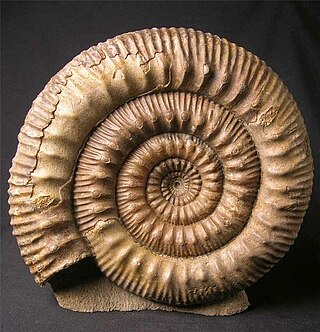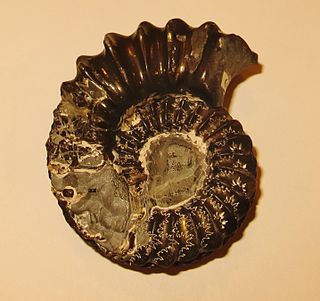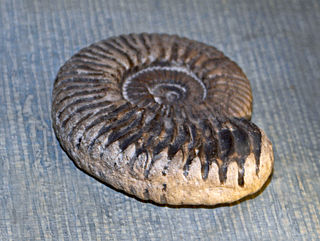
Stephanoceras is an extinct genus of Stephanoceratoid ammonite which lived during the Bajocian. It is the type genus of the family Stephanoceratidae.

Xipheroceras is a Lower Jurassic ammonite belonging to the Eoderoceratidae, and sometimes placed in the subfamily Xipheroceratinae for which it is the namesake. It has been found in the upper Sinemurian of Europe and possibly Borneo.
Analytoceras is an extinct genus of cephalopod belonging to the Ammonite subclass that lived during the early Jurassic. Analytoceras, named by Alpheus Hyatt in 1900, is a lytoceratid and only member of the pleuroacanthitid subfamily Analytoceratinae, which has the same characters as its genus.
Bifericeras is a Lower Jurassic ammonite belonging to the family Eoderoceratidae, and sometimes placed in the subfamily Xipherceratinae. Whorls are strongly depressed, but still evolute in coiling. The early growth state is prolonged, and smooth, followed by a late growth stage with rounded, straight, bituberculate ribs.
Unipeltoceras is an extinct ammonite genus included in the perisphictacian family, Aspidoceratidae, and a member of the subfamily Peltoceratinae, that lived during the Callovian stage, late in the Middle Jurassic.

Ammonitina comprises a diverse suborder of ammonite cephalopods that lived during the Jurassic and Cretaceous periods of the Mesozoic Era. They are excellent index fossils, and it is often possible to link the rock layer in which they are found to specific geological time periods.
Dorsetensia is a narrowly coiled discoidal ammonite from the early Middle Jurassic, lower Bajocian, belonging to the family Sonniniidae of the superfamily Hildoceratoidea. The inner whorls are ribbed or smooth, outer whorl is smooth. The outer rim (venter) is narrow, with a keel running along the middle. The umbilicus, the opening in the middle of the shell exposing inner whorls, is of moderate size with a sharp, sometimes undercut edge.

Peltoceras is an extinct ammonite genus from the aspidoceratid subfamily Peltoceratinae that lived during the later part of the Middle Jurassic.

Stephanoceratoidea, formerly Stephanocerataceae, is a superfamily of middle- upper Jurassic ammonoid cephalopods within the order Ammonitida containing diverse forms, generally with sharp ribbing and complex suture lines. Aptychi are believed to be mostly granular (Granulaptycus) or concentrically ribbed on the surface (Praestriaptychus)
Subcollina is a genus of evolute to serpenticonic stephanoceratacean ammonites from the Middle Jurassic (Baj) of Mexico, placed in the family Spiroceratidae.

Eoderoceratoidea is a superfamily of true ammonites from the Lower Jurassic, comprising seven phylogenetically related families, characterized in general by having ribbed evolute shells that commonly bear spines or tubercles. Adult shell size ranges from 2 or 3 cm to giants reaching 50 cm in such genera as Apoderoceras, Epideroceras, and Liparoceras.
Coeloceratidae is a family of ammonites belonging to the Eoderoceratoidea that lived during the Early Jurassic. Shells are evolute, tending to be broadly discoidal with depressed whorls bearing primary and secondary ribs that branch from outer lateral tubercles. Most of the included species have coronate inner whorls and outer tubercles only. In general, Coeloceratids resemble the Middle Jurassic Stephanoceras. Once regarded as the subfamily Coeloceratinae in the Eoderoceratidae, these ammonites are now given familial rank.
Eoderoceras is an evolute, round whorled ammonite from the Lower Jurassic with an outer row of distinct spines, and in some, an inner row of tubercles, on either side; ribs only on the inner whorls.
Crucilobiceras is an ammonoid cephalopod genus from the Lower Jurassic belonging to the eoderoceratoidean family Eoderoceratidae. Cruciliboceras has an evolute shell, such that all whorls are well exposed, with persistent radial ribbing and with spines or tubercles on the outer, ventral, rim, and in some, tubercles in the inner, umbilical, rim. The genus Crucilobiceras is commonly found along the Jurassic Coast of England.

Kepplerites is a moderately evolute ammonite from the lower Callovian included in the Stephanoceratoidea.

Hecticoceras is an ammonite genus belonging to the haploceratoid family Oppeliidae, that lived during the Middle and Late Jurassic, from the Callovian. Hecticoceras may be seen as a series of some nine subgenera, beginning with the lower Callovian H. (Hecticoceras) and H. (Hecticoceratoides) and ending with the lower Oxfordian H. (Pseudobrightia) and H. (Eochetoceras). Hecticocerassensu lato and Prohecticoceras from the underlying Bathonian form the oppeliid subfamily, Hecticoceratinae.

The Peltoceratinae comprise a subfamily in the Aspidoceratidae,.
Polymorphitidae is a family of Early Jurassic ammonoid cephalopods that contribute to the Eoderoceratoidea. Two subfamilies, the Polymorphtinae and Tropidoceratinae, are included.
Ochetoceras is a genus of ammonites, belonging to the Oppeliidae, that lived during the Late Jurassic from the early Oxfordian to the early Tithonian, and type for the subfamily Ochetoceratinae.

Hammatoceras is a genus of ammonites belonging to the family Hammatoceratidae which lived during the Toarcian stage of the Early/Lower Jurassic between about 184 and 175 million year ago.









